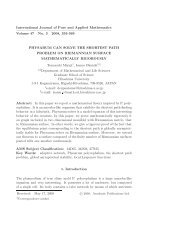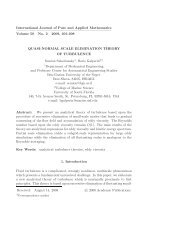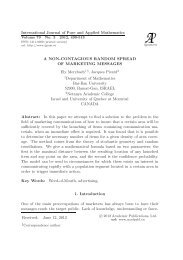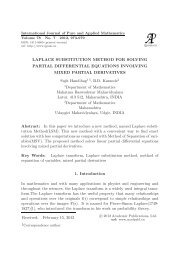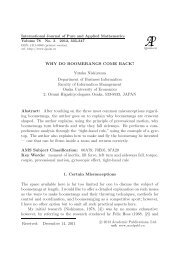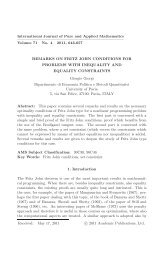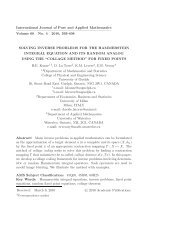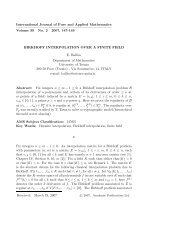CAVITATION, INDENTATION AND PENETRATION
CAVITATION, INDENTATION AND PENETRATION
CAVITATION, INDENTATION AND PENETRATION
You also want an ePaper? Increase the reach of your titles
YUMPU automatically turns print PDFs into web optimized ePapers that Google loves.
International Journal of Pure and Applied Mathematics<br />
————————————————————————–<br />
Volume 42 No. 3 2008, 361-367<br />
<strong>CAVITATION</strong>, <strong>INDENTATION</strong> <strong>AND</strong> <strong>PENETRATION</strong><br />
David Durban1 , Rami Masri2 §<br />
1,2 Faculty of Aerospace Engineering<br />
Technion – Israel Institute of Technology<br />
Haifa, 32000, ISRAEL<br />
1 e-mail: aer6903@tx.technion.ac.il<br />
2 e-mail: masri@tx.technion.ac.il<br />
Abstract: Elastoplastic deformation patterns, induced by expanding cavities,<br />
provide useful analytical models in applied mechanics and engineering. Applications<br />
range from material hardness indentation tests to dynamic penetration<br />
of projectiles. Recent advances in deriving analytical solutions for steady state<br />
expanding cavities enable the construction of highly accurate formulae for cavitation<br />
pressure, accounting for strain hardening and elastic compressibility. For<br />
dynamic fields, solutions are described by Mach number (relative to medium<br />
wave velocity) power series with coefficients that depend on elastic and plastic<br />
moduli. Cylindrical quasi-static cavitation solutions have been obtained for<br />
both Mises and Tresca solids.<br />
AMS Subject Classification: 74C15<br />
Key Words: plasticity, large strains<br />
1. Cavitation<br />
Cavitation phenomena in elastoplastic solids, originally observed by Bishop<br />
et al[1], are widely used in simulating penetration, Masri[9], and indentation,<br />
Durban and Masri[4], processes. Early results, Hill[6], for elastic/perfectlyplastic<br />
solids, are given by the cavitation pressure (pc) formulae<br />
spherical cavity (Mises and Tresca)<br />
pc = 2<br />
3 Y<br />
<br />
<br />
E<br />
1 + ln , (1)<br />
3(1 − ν)Y<br />
Received: August 17, 2007 c○ 2008, Academic Publications Ltd.<br />
§ Correspondence author
362 D. Durban, R. Masri<br />
cylindrical cavity (Mises)<br />
pc = 1<br />
√ 3 Y<br />
√ <br />
3E<br />
1 + ln , (2)<br />
(5 − 4ν)Y<br />
cylindrical cavity (Tresca)<br />
pc = 1<br />
2 Y<br />
<br />
<br />
2E<br />
1 + ln . (3)<br />
(5 − 4ν)Y<br />
Here, Y is the yield stress, E – elastic modulus, ν – Poisson ratio. For a<br />
pressurized spherical cavity both Mises and Tresca yield conditions coincide<br />
due to spherical symmetry of the stress field. However, they differ in planestrain<br />
axially-symmetric fields implying the difference between (2) and (3).<br />
Cavitation pressure serves as an extreme measure of strength of elastoplastic<br />
solids. The dynamic version of pc has been successfully applied to impact<br />
penetration, Masri[9], in the spirit of the methodology suggested by Goodier[5].<br />
A detailed review of earlier work on dynamic cavitation by Hopkins[7] concentrates<br />
on incompressible elastic/perfectly-plastic material. An elegant expres-<br />
sion due to Hill is available for spherical cavities, namely,<br />
Pc = pc<br />
E<br />
= 2<br />
3 Σy<br />
<br />
1 + ln 2<br />
3Σy<br />
<br />
+ 3<br />
2 m2 , (4)<br />
where Σy = Y/E and m = ˙ A/ E/ρ0, ˙ A is the cavity expansion velocity and<br />
ρ0 the density.<br />
A possible analogue of (4) for plane-strain cylindrical dynamic cavitation in<br />
incompressible Mises solids has been given recently by Masri and Durban[11]<br />
in the form<br />
Pc = Σy<br />
<br />
Σy<br />
√3 +<br />
√3 + m2<br />
2<br />
<br />
ln<br />
1<br />
√ 3Σy + 3<br />
2 m2<br />
<br />
. (5)<br />
This solution however is not perfect as small stresses are required in the far<br />
field to sustain the expansion process.<br />
2. Indentation<br />
Both experimental data, Johnson[8], and numerical analysis, Casalas and Alcala[2],<br />
indicate the existence of a spherical cavity expansion field beneath rigid axisymmetric<br />
indenters (Figure 1).<br />
The general result for quasi-static spherical cavitation pressure, Durban and
<strong>CAVITATION</strong>, <strong>INDENTATION</strong> <strong>AND</strong> <strong>PENETRATION</strong> 363<br />
Figure 1: Conical indentation. Included angle is 2α, imprint radius – a,<br />
hypothetical radial displacement – w. Inner core is bounded by r = a.<br />
Baruch [3], is<br />
Pc =<br />
∞<br />
0<br />
exp( 3<br />
2<br />
Σ (dǫ + βdΣ)<br />
β<br />
ǫ − 2Σ) − 1 + 2βΣ<br />
and for quasi-static, plain strain, cylindrical cavitation of compressible Mises<br />
and Tresca solids we have the general results, Masri and Durban [12], respec-<br />
tively<br />
and<br />
Pc =<br />
∞<br />
0<br />
Σ dǫ + 1−2κ<br />
3 βdΣ<br />
√3ǫ <br />
β<br />
exp − √3Σ − 1 + 2(1−κ)<br />
√ βΣ<br />
3<br />
∞<br />
<br />
Σ dǫ −<br />
<br />
2<br />
1−β<br />
2 dΣ<br />
(6)<br />
with κ = −0.4725, (7)<br />
Pc =<br />
0 exp(2ǫ − 1+β 3−β<br />
2 Σ) − 1 + 2 βΣ.<br />
(8)<br />
Here the total strain ǫ is a known function of the effective Mises stress Σ (nondimensionalized<br />
with respect to E) and β = 1 − 2ν is a compressibility measure.<br />
Formulae (6-8) generalize approximations (1-3) to include strain hardening. In<br />
the absence of elastic compressibility (β = 0) it is possible, Masri and Durban<br />
[13], to derive for power hardening materials the close approximations<br />
Pc = 2<br />
3 Σy<br />
n 2<br />
1 + F(n) −<br />
3Σy<br />
1<br />
<br />
, (9)<br />
n
364 D. Durban, R. Masri<br />
with<br />
η T =<br />
Pc =<br />
Pc = 1<br />
<br />
√ Σy 1 +<br />
3<br />
<br />
2<br />
Σy 1 +<br />
4 − ηT 1 − η T ln<br />
n 1<br />
2Σy<br />
<br />
1 π2 2Σy 6<br />
F(n) − 1<br />
n<br />
− 1 − ln<br />
<br />
1 − ln<br />
1<br />
2Σy<br />
2Σy<br />
<br />
n F(n) − 1<br />
<br />
,<br />
n<br />
(10)<br />
n 4 1<br />
+ F(n) −<br />
3 2Σy<br />
1<br />
<br />
,<br />
n<br />
(11)<br />
1<br />
√ 3Σy<br />
and F(n) = ζ(1 + n)Γ(1 + n), (12)<br />
where n is the hardening exponent and ζ and Γ denote the Zeta and Gamma<br />
functions, respectively.<br />
Durban and Masri[4] have examined the relation between the average indentation<br />
pressure of standard conical indenter, identified with material hardness<br />
H, and quasi-static cavitation pressures. It turns out that for power law response,<br />
in plastic range, there is a good agreement between Pc of (8) and the<br />
hardness (H/E).<br />
3. Penetration<br />
Following Goodier[5] it is assumed that the pressure on the penetrator is given<br />
by the local dynamic cavitation pressure. Considering steady-state dynamic<br />
expansion of a spherical cavity, Masri and Durban [10], we introduce the nondimensional<br />
coordinate ξ = R/A, where R is the radial coordinate and A the<br />
instantaneous cavity radius. For self similar expansion fields we use the transformation<br />
( ˙)<br />
= ˙ d( )<br />
ξ<br />
dξ = ˙ A )<br />
(V − ξ)d(<br />
A dξ , where V = ˙ R/ ˙ A. (13)<br />
With the J2 theory of plasticity it is possible to reduce the governing equations<br />
to the non-linear couple<br />
βΣ ′ β<br />
r +<br />
2 Σ′ + 1<br />
2 ǫ′ = 1<br />
β<br />
−<br />
1 − e 2<br />
ξ<br />
Σ+3 2ǫ , (14)<br />
Σ ′ r − 2<br />
ξ Σ = m2 ξ 2 βΣ ′ r + βΣ ′ − ǫ ′ e −3βΣr−βΣ−3ǫ , (15)<br />
where radial stress Σr and effective stress Σ are nondimensionalized with respect<br />
to E and a superposed prime denotes differentiation with respect to ξ.<br />
Numerical solutions of (14)-(15) provide the dependence of Pc on m. However,<br />
for elastic/perfectly-plastic solids it is instructive to peruse a power expansion
<strong>CAVITATION</strong>, <strong>INDENTATION</strong> <strong>AND</strong> <strong>PENETRATION</strong> 365<br />
P c<br />
0.14<br />
0.12<br />
0.1<br />
0.08<br />
0.06<br />
0.04<br />
Titanium<br />
Stainless steel<br />
Steel<br />
Aluminum<br />
0.02<br />
0 0.05 0.1 0.15 0.2 0.25 0.3<br />
m<br />
Figure 2: Variation of cavitation pressure Pc with expansion velocity m<br />
for four metals. The different markers represent the power expansion<br />
solution (16) with Σ∗ y instead of Σy.<br />
solution, valid for the practical range m 2 ≪ 1, and the dynamic cavitation<br />
pressure follows, to the third order, as<br />
Pc = P0 + P1m + P2m 2 + P3m 3 , (16)<br />
where coefficient P0 is the quasi-static cavitation pressure (1) normalized by E,<br />
P1 = 0 (no linear term) and<br />
<br />
2<br />
3<br />
P3 = − 2<br />
<br />
β<br />
9<br />
P2 = 3<br />
2 −<br />
2<br />
3 (7 + 5<br />
3 β)<br />
(1 + β) 5<br />
3<br />
βΣ 1<br />
3<br />
y , (17)<br />
5 (3 − β)<br />
. (18)<br />
(1 + β)<br />
Relation (16) applies also to strain hardening solids if Σy is replaced by an<br />
equivalent cavitation yield stress Σ ∗ y obtained by equating (6) with (1), where in<br />
the latter Σy is replaced with Σ ∗ y. Comparison between numerical solutions of<br />
(14)-(15) and the power expansion (16), for several metals, is shown in Figure<br />
2 revealing excellent agreement.
366 D. Durban, R. Masri<br />
4. Conclusions<br />
Cavitation driven processes like axially symmetric indentation and dynamic<br />
penetration can be analyzed with the aid of plastic cavitation fields. A range of<br />
basic solutions is now available for spherical and cylindrical patterns accounting<br />
for strain hardening and elastic compressibility. Future research will include<br />
cavitation phenomena in pressure sensitive solids, strain gradient effects and<br />
influence of temperature and loading rate.<br />
References<br />
[1] R.F. Bishop, R. Hill, N.F. Mott, The theory of indentation and hardness,<br />
Proc. Phys. Soc., 57 (1945), 147-159.<br />
[2] O. Casals, J. Alcalá, The duality in mechanical property extractions<br />
from Vickers and Berkovich instrumented indentation experiments, Acta.<br />
Mater., 53 (2005), 3545-3561.<br />
[3] D. Durban, M. Baruch, On the problem of a spherical cavity in an infinite<br />
elasto-plastic medium, J. Appl. Mech., 43 (1976), 633-638.<br />
[4] D. Durban, R. Masri, Conical indentation of strain-hardening solids, Eur.<br />
J. Mech. A – Solids, To Appear.<br />
[5] J.N. Goodier, On the mechanics of indentation and cratering in the solid<br />
targets of strain-hardening metal by impact of hard and soft sphers, In:<br />
Proceedings of the 7-th Symposium on Hypervelocity Impact, III (1965),<br />
215-259.<br />
[6] R. Hill, The Mathematical Theory of Plasticity, Oxford University Press<br />
(1950).<br />
[7] H.G. Hopkins, Dynamic expansion of spherical cavities in metal, In:<br />
Progress in Solid Mechanics (Ed-s: I.N. Sneddon), Volume 1, North-<br />
Holland (1960).<br />
[8] K.L. Johnson, Contact Mechanics, Cambridge University Press (1985).<br />
[9] R. Masri, Cavity Expansion in an Elstoplastic Medium – Theory and Applications,<br />
Ph.D. Thesis, Technion, Israel (2007).
<strong>CAVITATION</strong>, <strong>INDENTATION</strong> <strong>AND</strong> <strong>PENETRATION</strong> 367<br />
[10] R. Masri, D. Durban, Dynamic spherical cavity expansion in an elastoplastic<br />
compressible Mises solid, J. Appl. Mech., 72 (2005), 887-898.<br />
[11] R. Masri, D. Durban, Dynamic cylindrical cavity expansion in an incompressible<br />
elastoplastic medium, Acta Mechanica, 181 (2006), 105-123.<br />
[12] R. Masri, D. Durban, Cylindrical cavity expansion in compressible Mises<br />
and Tresca solids, Eur. J. Mech. A – Solids, 26 (2007), 712-727.<br />
[13] R. Masri, D. Durban, Accurate formulae for elastoplastic cavitation pressure,<br />
In Preparation.
368



